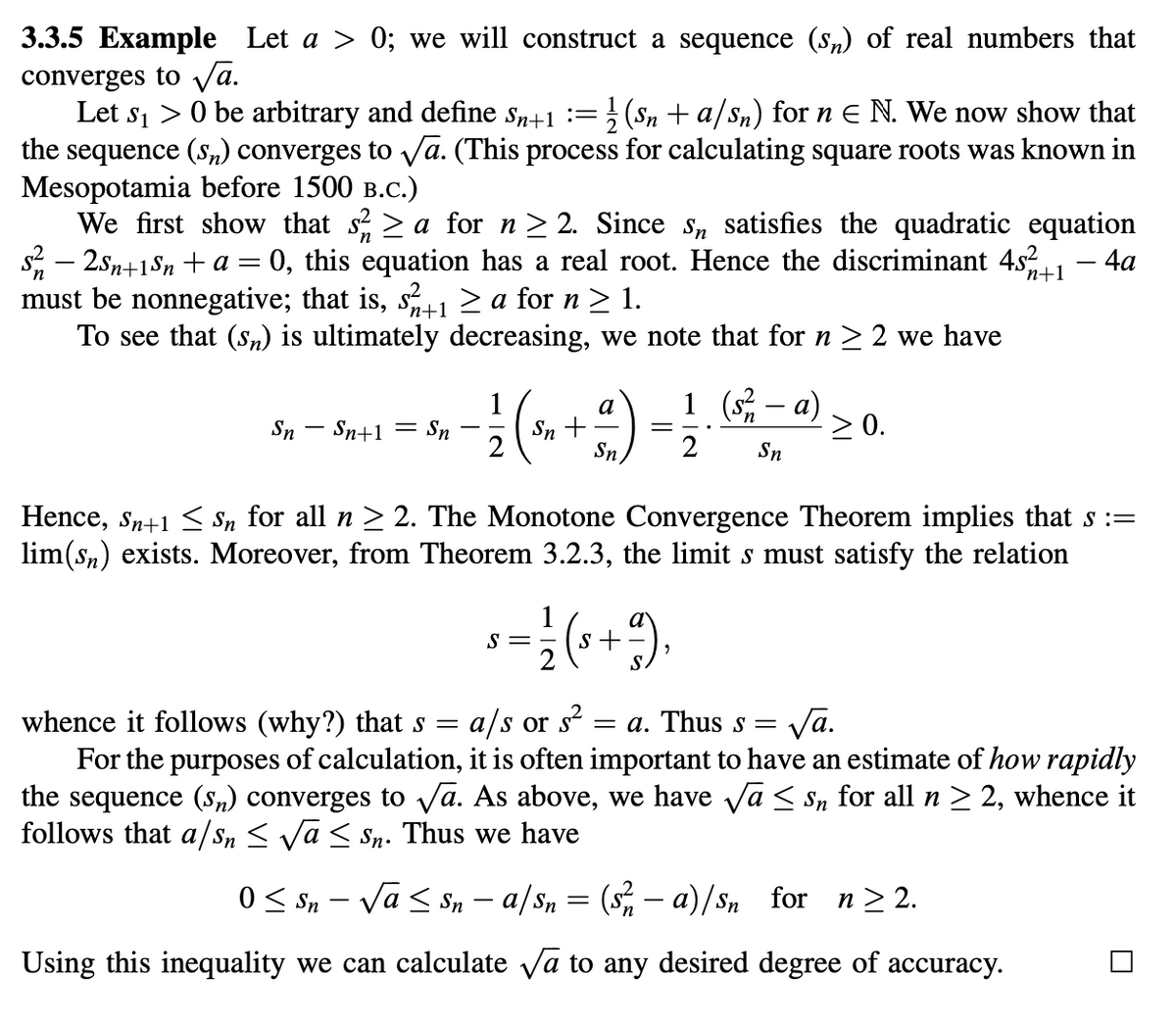3.3.5 Example Let a > 0; we will construct a sequence (s) of real numbers that converges to √a. 2 Let s₁ > 0 be arbitrary and define Sn+1 := (Sn+a/sn) for n = N. We now show that the sequence (Sn) converges to √✓a. (This process for calculating square roots was known in Mesopotamia before 1500 B.C.) - We first show that s² 2 ≥ a for n ≥ 2. Since s, satisfies the quadratic equation s² − 2Sn+1Sn + a = 0, this equation has a real root. Hence the discriminant 45% 24+ must be nonnegative; that is, s² (24+1 ≥ a for n ≥ 1. To see that (Sn) is ultimately decreasing, we note that for n ≥ 2 we have n+1 - 4a a 1 (s² - a) Sn Sn+1 = Sn Sn + ≥ 0. Sn 2 Sn Hence, Sn+1 ≤ sɲ for all n ≥ 2. The Monotone Convergence Theorem implies that s := lim(Sn) exists. Moreover, from Theorem 3.2.3, the limit s must satisfy the relation whence it follows (why?) that s = S= 2 (+9 a/s or s² = a. Thus s = √a. For the purposes of calculation, it is often important to have an estimate of how rapidly the sequence (Sn) converges to √a. As above, we have √√α ≤ sn for all n ≥ 2, whence it follows that a/s, ≤ √√α ≤ Sn. Thus we have 0 ≤ Sn – √√α ≤ sn – a/Sn = (s²/ − a)/Sn for n ≥2. - Using this inequality we can calculate ✓a to any desired degree of accuracy.
3.3.5 Example Let a > 0; we will construct a sequence (s) of real numbers that converges to √a. 2 Let s₁ > 0 be arbitrary and define Sn+1 := (Sn+a/sn) for n = N. We now show that the sequence (Sn) converges to √✓a. (This process for calculating square roots was known in Mesopotamia before 1500 B.C.) - We first show that s² 2 ≥ a for n ≥ 2. Since s, satisfies the quadratic equation s² − 2Sn+1Sn + a = 0, this equation has a real root. Hence the discriminant 45% 24+ must be nonnegative; that is, s² (24+1 ≥ a for n ≥ 1. To see that (Sn) is ultimately decreasing, we note that for n ≥ 2 we have n+1 - 4a a 1 (s² - a) Sn Sn+1 = Sn Sn + ≥ 0. Sn 2 Sn Hence, Sn+1 ≤ sɲ for all n ≥ 2. The Monotone Convergence Theorem implies that s := lim(Sn) exists. Moreover, from Theorem 3.2.3, the limit s must satisfy the relation whence it follows (why?) that s = S= 2 (+9 a/s or s² = a. Thus s = √a. For the purposes of calculation, it is often important to have an estimate of how rapidly the sequence (Sn) converges to √a. As above, we have √√α ≤ sn for all n ≥ 2, whence it follows that a/s, ≤ √√α ≤ Sn. Thus we have 0 ≤ Sn – √√α ≤ sn – a/Sn = (s²/ − a)/Sn for n ≥2. - Using this inequality we can calculate ✓a to any desired degree of accuracy.
Algebra & Trigonometry with Analytic Geometry
13th Edition
ISBN:9781133382119
Author:Swokowski
Publisher:Swokowski
Chapter10: Sequences, Series, And Probability
Section10.2: Arithmetic Sequences
Problem 67E
Related questions
Question
Use the method in Example 3.3.5 to calculate Sqrt(2), correct to within 4 decimals.

Transcribed Image Text:3.3.5 Example Let a > 0; we will construct a sequence (s) of real numbers that
converges to √a.
2
Let s₁ > 0 be arbitrary and define Sn+1 := (Sn+a/sn) for n = N. We now show that
the sequence (Sn) converges to √✓a. (This process for calculating square roots was known in
Mesopotamia before 1500 B.C.)
-
We first show that s² 2 ≥ a for n ≥ 2. Since s, satisfies the quadratic equation
s² − 2Sn+1Sn + a = 0, this equation has a real root. Hence the discriminant 45% 24+
must be nonnegative; that is, s² (24+1 ≥ a for n ≥ 1.
To see that (Sn) is ultimately decreasing, we note that for n ≥ 2 we have
n+1
- 4a
a
1 (s² - a)
Sn Sn+1 = Sn
Sn +
≥ 0.
Sn
2
Sn
Hence, Sn+1 ≤ sɲ for all n ≥ 2. The Monotone Convergence Theorem implies that s :=
lim(Sn) exists. Moreover, from Theorem 3.2.3, the limit s must satisfy the relation
whence it follows (why?) that s
=
S=
2
(+9
a/s or s² = a. Thus s =
√a.
For the purposes of calculation, it is often important to have an estimate of how rapidly
the sequence (Sn) converges to √a. As above, we have √√α ≤ sn for all n ≥ 2, whence it
follows that a/s, ≤ √√α ≤ Sn. Thus we have
0 ≤ Sn – √√α ≤ sn – a/Sn = (s²/ − a)/Sn for n ≥2.
-
Using this inequality we can calculate ✓a to any desired degree of accuracy.
Expert Solution
This question has been solved!
Explore an expertly crafted, step-by-step solution for a thorough understanding of key concepts.
This is a popular solution!
Trending now
This is a popular solution!
Step by step
Solved in 2 steps

Recommended textbooks for you

Algebra & Trigonometry with Analytic Geometry
Algebra
ISBN:
9781133382119
Author:
Swokowski
Publisher:
Cengage

Algebra & Trigonometry with Analytic Geometry
Algebra
ISBN:
9781133382119
Author:
Swokowski
Publisher:
Cengage